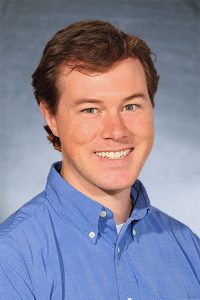Ask the Expert: Brett Compton
 Brett Compton began his career as a post-doctoral research fellow at Harvard University before coming to ORNL’s Manufacturing Demonstration Facility. Now an assistant professor in UT’s Department of Mechanical, Aerospace, and Biomedical Engineering, Compton recently talked about the UT-ORNL advantage when it comes to the future of advanced manufacturing (AM).
Brett Compton began his career as a post-doctoral research fellow at Harvard University before coming to ORNL’s Manufacturing Demonstration Facility. Now an assistant professor in UT’s Department of Mechanical, Aerospace, and Biomedical Engineering, Compton recently talked about the UT-ORNL advantage when it comes to the future of advanced manufacturing (AM).
How does advanced manufacturing draw upon various disciplines?
Compton: Successful AM relies on the integration of precision motion control and robotics, materials science and process-structure-property relationships, and mechanical design. In addition, optimization of a given process may require real-time sensing and feedback, data mining and cross-correlation from large data sets, and advanced path planning. Thus, AM incorporates aspects of robotics, materials science, industrial engineering, computers science, electrical engineering, and design.
What are some of the advantages of UT and ORNL working together, particularly at MDF?
Compton: The relationship is highly beneficial to both parties and increases the opportunities for impactful research by creating a pipeline between fundamental, lab-scale research at the university and highly applied, large-scale projects at MDF. In addition, the industry-focused projects at MDF provide a strong commercial pull that guides and highlights the most relevant fundamental research challenges that can be addressed with university research. MDF and ORNL benefit from having a steady stream of creative engaged students from UT, and UT benefits from the public awareness that large-scale MDF projects bring.
How does UT help prepare students for future roles in the field, whether as employees or researchers?
Compton: UT offers a unique environment for students that provides unprecedented exposure to a broad range of state-of-the-art AM processes and projects through the faculty and research at UT and the close proximity and collaboration with ORNL. With many faculty jointly appointed or closely collaborating with experts at ORNL, students gain experience in the normal course of their studies that students at other universities cannot get without participating in a dedicated internship.
What are some specific projects and research that you have done?
Compton: I have done projects on composites, polymers, and AM compiled rare earth bonded magnets with partners including ORNL, the Air Force Research Laboratory, the Army Aviation and Missile Research Development and Engineering Center, the Kansas City Nuclear Security Campus, and Lehigh University, among others.